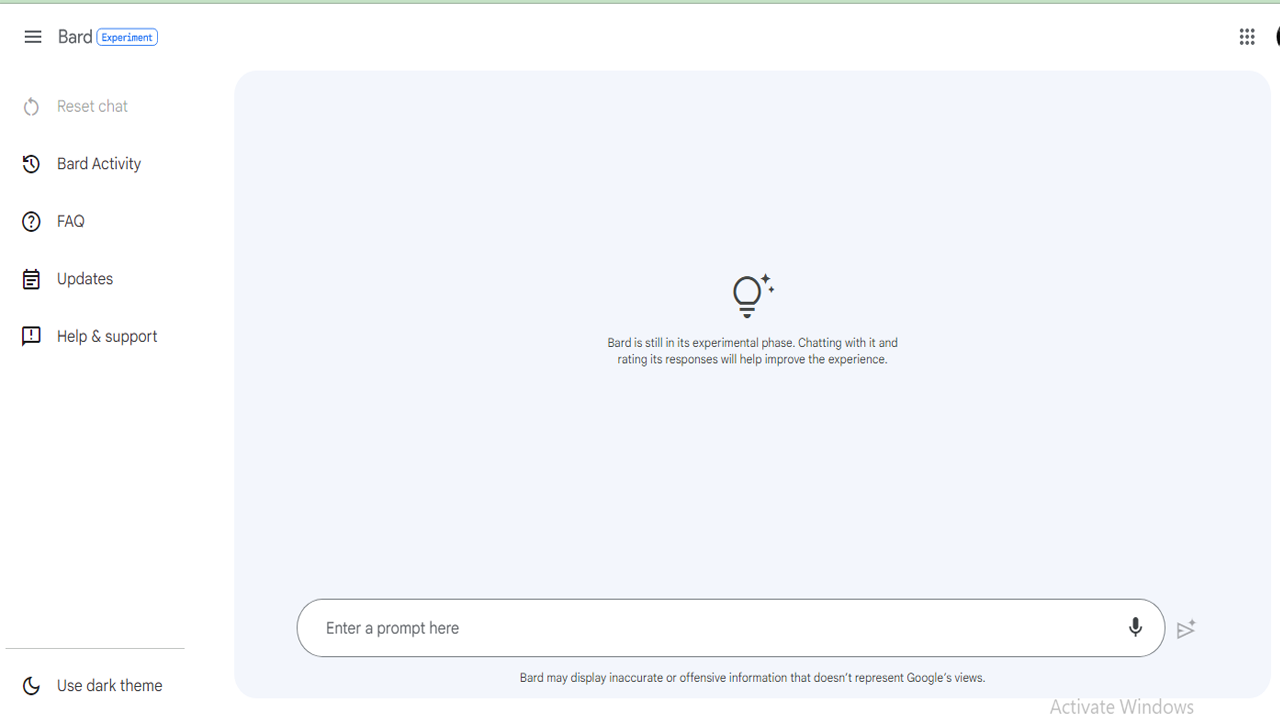The latest Google Bard Features are taking the Generative AI curve to in the favour of the Google ChatBot’s favour as compared to ChatGPT. Google is making a number of major updates to its AI chatbot Bard, including support for new languages, easier ways to export text, visual search, and a dark mode.
Table of Contents
No More waitlist
The company is also removing the waitlist for Bard and making it available in English in 180 countries and territories.
These changes are a significant improvement for Bard, which was released two months ago for a limited number of users in the US and UK.
The chatbot, which Google still stresses is an experiment and not a replacement for its search engine, has been compared unfavorably to rivals like OpenAI’s ChatGPT and Microsoft’s new Bing chatbot.
Notably, Bard made a factual error in its first-ever public demo (though this problem is common to all such bots).
By adding new features and upgrading Bard to use its new PaLM 2 language model, Google is hoping to improve the chatbot’s general answers and usability.
These changes could make Bard a more competitive option in the crowded field of AI chatbots.
Google’s Bard chatbot, which was released two months ago for select users in the US and UK, is getting a boost. Google is adding a lot of new features and upgrading Bard to use its new PaLM 2 language model.
This should improve Bard’s general answers and usability. The upgrade to PaLM 2 will give Bard access to a larger and more powerful language model.
This should allow Bard to generate more accurate and informative answers, as well as to better understand and respond to complex questions.
Google is also promising future features for Bard, such as AI image generation powered by Adobe and integration with third-party web services like Instacart and OpenTable.
Overall, these are significant updates for Google Bard features, and they could make it a more competitive option in the crowded field of AI chatbots.
Better Coding
Google has announced a major update to its AI chatbot Bard, making it even better at coding.
Bard can now debug and explain chunks of code in more than 20 languages, and it can also export code to Google’s Colab platform and Replit.
One of the biggest improvements is the new dark mode, which makes it easier to code in low-light conditions. Bard has also been upgraded with improved citations for code, which will not only offer sources but also explain the snippets.
Overall, these are significant updates for Bard, and they could make it a more competitive option in the crowded field of AI chatbots.
Here are some of the key new features of Bard for coding:
- Dark mode: Bard now has a dark mode option, which can be helpful for users who want to code in low-light conditions.
- Improved citations for code: Bard can now provide citations for code, which can help users to understand the source of the code.
- Export to Colab and Replit: Bard can now export code to Google’s Colab platform and Replit.
These new features make Bard a more powerful and versatile tool for coding. If you are a developer, I encourage you to check out Bard and see how it can help you with your work.
Google Bard Features Google Bard Gets a Visual Makeover
visual makeover is one the latest Google Bard features. The AI chatbot will soon be able to analyze images, provide images in query results, and generate visuals using AI.
This new feature is powered by Adobe’s Firefly software and will be available in the coming months.
The visual results will appear in Bard in the same way they do in Google queries.
For example, if you ask Bard “what are some must-see sights in New Orleans?”,
the system will generate a list of relevant locations, such as the French Quarter and the Audubon Zoo, along with images of those locations.
This new feature will make Bard more user-friendly and informative, and it will help users to better understand the information that Bard provides.
Here are some of the benefits of the new visual search feature in Google Bard:
- It will make Bard more user-friendly and informative.
- It will help users to better understand the information that Bard provides.
- It will make Bard more visually appealing.
- It will make Bard more competitive with other AI chatbots.
The Major Features of Google Bard
Answer your questions in an informative way, even if they are open ended, challenging, or strange. Bard is trained on a massive amount of text data, and is able to communicate and generate human-like text in response to a wide range of prompts and questions. For example, Bard can provide summaries of factual topics or create stories.
Generate different creative text formats, like poems, code, scripts, musical pieces, email, letters, etc. Bard can generate different creative text formats of text content, like poems, code, scripts, musical pieces, email, letters, etc. It will try its best to fulfill all your requirements.
Translate languages. Bard can translate between over 200 languages. This makes it a valuable tool for anyone who needs to communicate with people who speak other languages.
Write different kinds of creative content. Bard can write different kinds of creative content, such as poems, code, scripts, musical pieces, email, letters, etc. It will try its best to fulfill all your requirements.
Write different kinds of creative content, like poems, code, scripts, musical pieces, email, letters, etc. Bard can write different kinds of creative content, such as poems, code, scripts, musical pieces, email, letters, etc. It will try its best to fulfill all your requirements.
Code generation. Bard can generate code in a variety of programming languages, including Python, Java, C++, and JavaScript. This makes it a powerful tool for developers and programmers.
Improved translation. Bard’s translation capabilities have been improved, making it more accurate and reliable. This makes it a valuable tool for anyone who needs to translate text from one language to another.
Enhanced creativity. Bard’s creativity has been enhanced, making it better at generating new ideas and concepts. This makes it a valuable tool for writers, artists, and creative professionals.
Expanded knowledge base. Bard’s knowledge base has been expanded, making it more knowledgeable about a wider range of topics. This makes it a more helpful and informative tool for users.
Improved performance. Bard’s performance has been improved, making it faster and more responsive. This makes it a more enjoyable and user-friendly tool.
Visual search: Bard can now analyze images, provide images in query results, and generate visuals using AI. This feature is powered by Adobe’s Firefly software and will be available in the coming months.
Dark mode: Bard now has a dark mode option, which makes it easier to use in low-light conditions.

Plugin support: Bard now supports plugins, which allows users to add new features and functionality to Bard.
Multimodal capabilities: Bard can now understand and respond to both text and images. This makes it more versatile and powerful than ever before.
Text-to-image generation: Image generation like DALLE is one of the best Google Bard Features which allows Bard users will soon be able to generate and edit images using Adobe Firefly and Express. Within Bard, users will be able to choose from templates, fonts, stock images, and other assets from the Express library.
Conlusion
Google Bard, the AI chatbot released two months ago, is receiving significant updates and new features that could make it more competitive with other AI chatbots.
Google is adding new languages, easier ways to export text, visual search, and a dark mode. These changes, along with an upgrade to its PaLM 2 language model, should improve Bard’s general answers and usability.
Additionally, the AI chatbot has been improved for coding with new features such as dark mode, improved citations for code, and export to Colab and Replit.
The new visual search and image generation feature powered by Adobe’s Firefly will also soon be available.
Overall, these updates make Bard a more powerful and versatile tool for coding and answering questions, generating creative text formats, and translating languages.
- These updates have the potential to make Bard more competitive in the crowded field of AI chatbots.
- Leonardo AI: Secrets of Powerful AI art Studio - May 20, 2023
- Google Bard Features :Easily Available to Everyone - May 12, 2023
- Google Bard vs ChatGPT: No. 1 The Ultimate Guide - May 7, 2023






